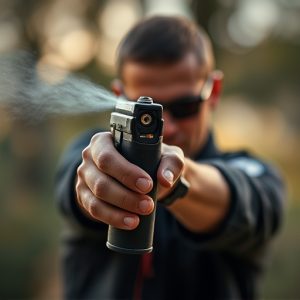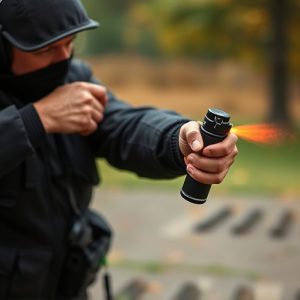OC Spray: Understanding Capsaicin Concentration for Personal Security
OC spray's effectiveness as a non-lethal self-defense tool depends on its capsicumin (capsaicin…….
OC spray's effectiveness as a non-lethal self-defense tool depends on its capsicumin (capsaicin) concentration, typically ranging from 1% to 2% for standard options and up to 10% or more for stronger variants. Balancing deterrence with safety, these levels cater to diverse user needs and legal considerations. Selecting OC spray involves understanding capsaicin mg/L measurements, reviewing user experiences, and considering regional laws that govern capsicum concentration levels (usually 2% to 10%). Responsible use includes acting proportionately, understanding deployment safety, and adhering to legal and ethical boundaries.
“In today’s world, personal safety is paramount. One innovative solution gaining traction is OC spray, a non-lethal deterrent known for its effectiveness in neutralizing threats. This article explores OC spray as a powerful personal security device, delving into its active ingredient, capsaicin concentration levels, and the science behind its functionality. We’ll also dissect safety considerations, legal implications, and the responsibilities that come with carrying such a device. By understanding these aspects, individuals can make informed decisions about their well-being.”
- Understanding OC Spray: A Non-Lethal Deterrent
- Capsaicin Concentration: The Active Ingredient
- Safety and Effectiveness Considerations
- Legal Aspects and Personal Responsibility
Understanding OC Spray: A Non-Lethal Deterrent
OC spray, short for Oleoresin Capsicum spray, is a popular non-lethal deterrent used for personal security. It works by delivering a potent irritant, capsicumin, derived from chili peppers. This substance stimulates nerve endings, causing a burning sensation and temporary incapacitation of the target. The effectiveness of OC spray lies in its capsaicin concentration levels; higher concentrations ensure quicker and more reliable results without causing permanent harm.
Manufacturers typically measure this concentration in percent or parts per million (ppm). A typical non-lethal self-defense spray may contain 1% to 2% capsaicin, while stronger options can go up to 10% or more. These varying levels cater to different needs and comfort zones for users, offering a balance between deterrence and safety. Understanding the OC spray capsicum concentration levels is crucial for ensuring its optimal use as a personal security device.
Capsaicin Concentration: The Active Ingredient
OC spray, a popular non-lethal deterrent, relies on capsaicin as its active ingredient to disrupt and incapacitate potential threats. The capsaicin concentration levels in these devices vary, typically ranging from 1% to 2%, providing just enough irritancy to disable an assailant temporarily without causing permanent harm.
This concentration is carefully calculated to ensure effectiveness while minimizing the risk of serious injury or long-term health issues for both users and bystanders. The specific level chosen often depends on factors like intended use, target audience, and legal considerations, making it a versatile solution for personal security in various settings.
Safety and Effectiveness Considerations
When considering non-lethal deterrent personal security devices, safety and effectiveness are paramount. One key component to evaluate is the capsaicin concentration levels in OC spray. The potency of capsicum oleoresin (OC) spray varies widely, typically measured in milligrams per liter (mg/L). Higher concentrations offer more protection but also increase the risk of unintended harm if not used properly. It’s crucial to choose a device with an appropriate capsaicin level for your needs and to familiarize yourself with its safe application methods.
Additionally, examining real-world effectiveness through user reviews and case studies is essential. Do the devices have proven track records in deterring potential threats? How do they perform under various conditions, such as weather or distance? Understanding these factors ensures that you’re investing in a reliable security tool that not only promises safety but also delivers in critical situations.
Legal Aspects and Personal Responsibility
When considering a non-lethal deterrent for personal security, it’s crucial to understand the legal aspects and personal responsibilities that come with its use. The legality of self-defense tools varies greatly by region, with specific regulations around items like pepper spray (OC Spray). In many jurisdictions, capsicum concentrations in OC Spray are strictly regulated; typically, these range from 2% to 10%, ensuring their effectiveness while mitigating risks. Users must familiarize themselves with local laws to avoid legal repercussions, as carrying an unauthorized device could lead to fines or other penalties.
Personal responsibility is another critical factor. Individuals equipped with non-lethal deterrents are still required to act reasonably and proportionately in response to threats. This includes understanding when and how to deploy the device safely, as misuse could cause harm to oneself or others. Regular training and awareness of one’s surroundings can help ensure that a non-lethal deterrent is employed appropriately, enhancing personal security without crossing legal or ethical boundaries.
OC Spray, with its capsaicin concentration levels, offers a powerful yet non-lethal deterrent for personal security. Understanding the active ingredient’s effectiveness and safety measures is crucial. However, users must also be aware of legal aspects and personal responsibility when carrying and employing such devices. In summary, OC Spray can be a valuable tool for self-defense when used responsibly and in accordance with local regulations.


